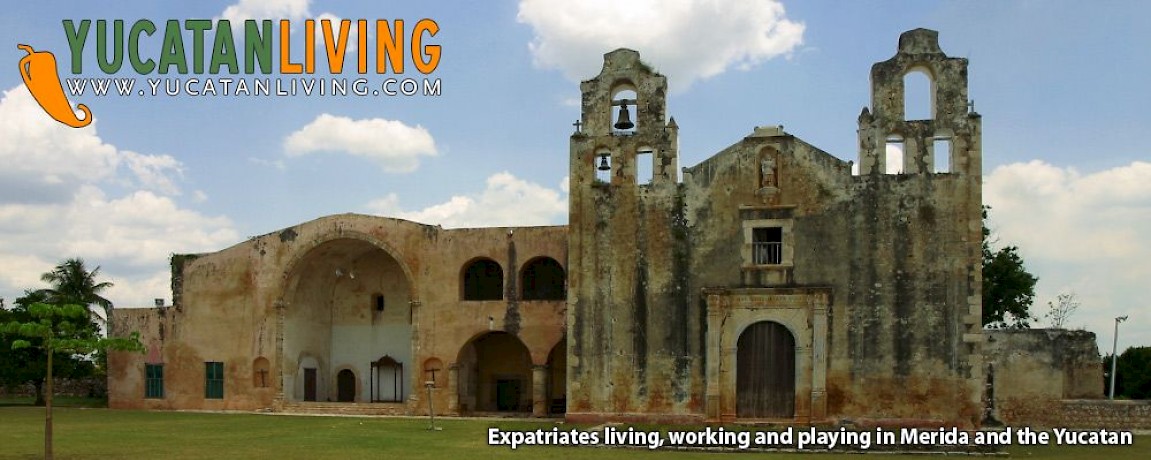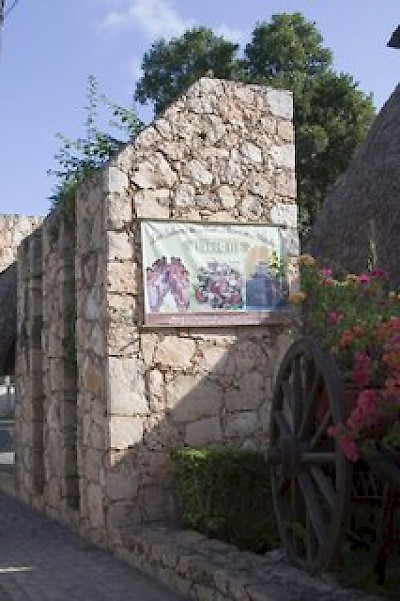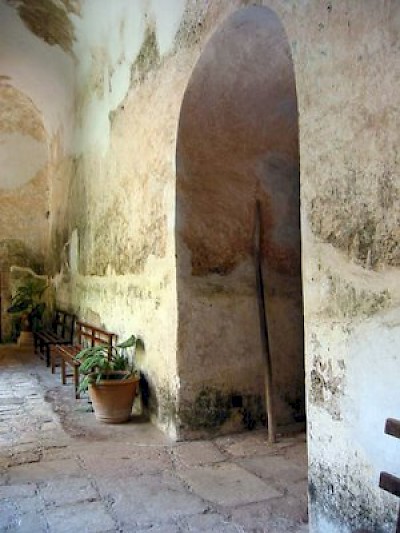The Ghosts of Mani
We've been to Mani twice, and its always been sunny, bright and warm. In other words, a typical Yucatan day. The pueblo centers around a large renovated iglesia (church) that is itself surrounded by a large open space. It takes a little over an hour to drive there from Merida, and you can continue on to Uxmal if you want to make a day of it.
Mani is a sleepy little Mayan pueblo. As in many places in the Yucatan, there are ghosts here, but you'd never know it.
The last time we went to Mani, we had breakfast at the second most famous thing about Mani, the restaurant called Tutul-Xiu. This restaurant is known for its delicious poc-chuc (a baked pork dish) and other authentic Yucatecan cuisine items. On weekends, we hear, the place is packed. When we were there, we were the only diners... but it is a large restaurant obviously used to bigger crowds. For the record, we had a delicious plate of huevos con chaya (scrambled eggs with the spinach-like vegetable that grows here called chaya) and huevos mexicanos (scrambled eggs with tomatoes and onions). The tortillas were handmade and hot from the griddle... there are no better tortillas in the world than hot-off-the-griddle Yucatecan tortillas. And the habanero sauce was hot and made us cry. The jarras de tamarindo and fresh orange juice helped a lot with that. In short, a great breakfast.
But enough about that.
There's also a very lovely and large church in Mani (see the first photo). The altar and the interior have recently been restored, and they are quite lovely and worth seeing. Attached to the main church is a monastery building where I'm sure monks and friars once lived while they were doing what Mani is *most* famous for. It is barely inhabited now... the huge rooms and patios with stone floors, the wide stairs, the thick arched walkways are all very still and a little eerie on a quiet Yucatecan afternoon.
What is really famous about Mani is something that happened here in 1562. The Franciscan missionaries living in this church discovered that the Mayans whom they thought were converted to Christianity had reverted to their traditional spiritual practices. Horrified, they began torturing various Mayans to find out what they were doing and where. Frey Diego de Landa, a senior monk, showed up and took over. He ordered all their books, statues and other accoutrements smashed and burned. Later in life he was quoted as saying, "We found a large number of books in these characters and, as they contained nothing in which were not to be seen as superstition and lies of the devil, we burned them all, which they (the Maya) regretted to an amazing degree, and which caused them much affliction". He burned countless precious books about the Mayans, their history and their spiritual beliefs and practices.
There were so many of these books (not just in Mani) that I've read some people have compared it to burning the library in Alexandria... in other words, erasing the major record of an entire culture. Today, so few of these codices or books have survived that they are well known by their names, which are derived from the locations where they are kept (such as the Dresden and Paris Codices). If you ever have a chance to see any of these in person, you will be amazed by the detail, color and beauty of the art that is Mayan writing.
Years later, it is said, Fray Diego de Landa bitterly regretted what he had done, thinking that he would have been able to convert the Mayans more easily if he had understood their religion and culture. Fool! He apparently spent the rest of his life recording whatever he could learn from the Mayans to try to make up for what had been lost. The result is a book that anyone interested in the Yucatan will find fascinating: "The Account of the Things of Yucatan" by Fray Diego de Landa. In the restaurant where we ate breakfast, we found a painting of the event. And on another wall is a complete accounting in Spanish of the event, including a recount of *exactly* how many statues, how many books and how many other things were confiscated and burned by the good Christians. The people of Mani have not forgotten, and the ghosts of their ancestors are very much present. When you visit, walk softly and with respect.
They may be watching.
For more information about Fray Diego de Landa and his terrible acts, try these pages:
http://www.latinamericanstudies.org/landa.htm
http://users.skynet.be/fa039055/lifedeat.htm
http://www.ancientamerica.org/library/media/384chapter13.htm
http://www.mexicanwave.com/blog/200507/20050701.html












Comments
Grant 19 years ago
I agree with Eric Thompson, the noted Mayan archaeologist, who wrote that we should stop the handwringing over Landa's book burning. The most important thing was to stop the institutionalized murder at the center of Mayan religion. Landa was there and thus in a far better position to know what steps were necessary than anyone living 500 years later. Stamping out that evil was worth just about any cost, as any of the reprieved victims would undoubtedly have agreed. Landa clearly was not a xenophobe, as his detailed and sympathetic account of Mayan culture demonstrates.
Reply
BillieS 19 years ago
I've been to Mani several times but it's been a while since I've been in Yucatan. I've got to get back.
Reply
Steve Bridger 19 years ago
Hi Ellen,
Nice write-up...I blogged about Mani last summer, too:
http://www.mexicanwave.com/blog/200507/20050701.html
saludos,
Steve
Reply
« Back (10 to 13 comments)